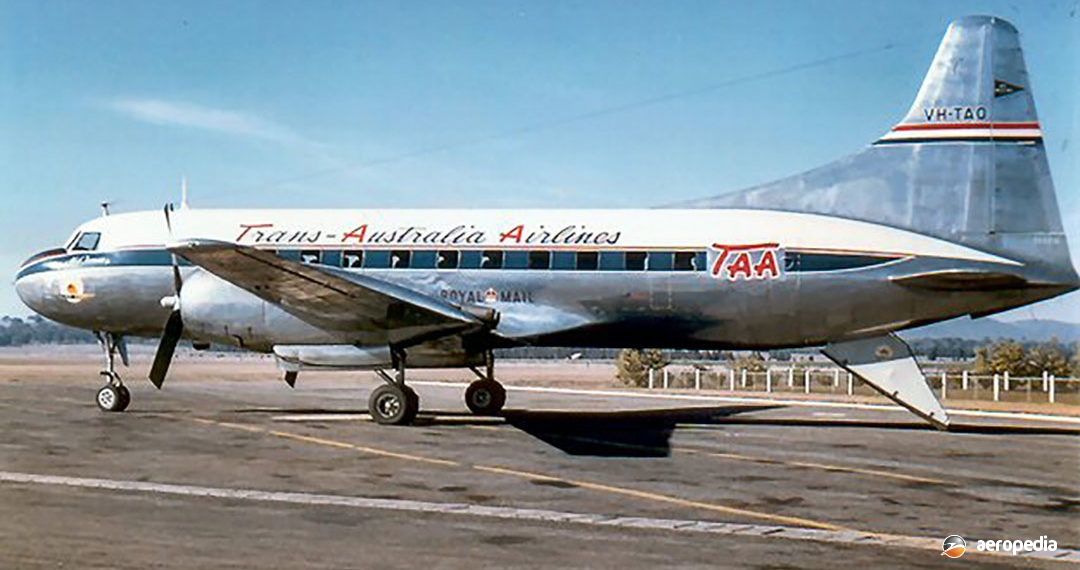Photograph:
Convair CV-240 VH-TAO (c/n 32) at Adelaide Airport, SA (Barry College)
Country of origin:
United States of America
Description:
Commercial airliner
Power Plant:
Two 1,567 kw (2,100 hp) Pratt & Whitney R-2800-CA18 Double Wasp eighteen-cylinder two-row air-cooled radial engines
Specifications:
- Wingspan: 27.97 m (91 ft 9 in)
- Length: 22.76 m (74 ft 8 in)
- Height: 8.82 m (26 ft 11 in)
- Wing area: 75.9 m² (817 sq ft)
- Max speed at 4,877 m (16,000 ft): 517 km/h (321 mph)
- Cruising speed at 4,877 m (16,000 ft): 468 km/h (291 mph)
- Landing speed with flaps: 137 km/h (85 mph)
- Initial rate of climb: 463 m/min (1,520 ft/min)
- Range with maximum payload: 2,900 km (1,800 miles)
- Empty weight: 11,542 kg (25,445 lb)
- Useful load: 6,829 kg (15,055 lb)
- Loaded weight: 18,956 kg (41,790 lb)
History:
The prototype of the Convair series of commercial airliners, the Model 110 (NX90653), was flown for the first time on 8 July 1946 at San Diego, California, being aimed at the market after World War II for the replacement of the Douglas DC-3. This was followed by the Series CV-240, which was probably the most advanced twin-engined passenger airliner of its day.
The design team was led by I M Laddon, which team had been asked by American Airlines to provide a DC-3 replacement, the specification requiring a 1,609 km (1,000 miles) range, the airlines initial order being for 100 aircraft, later reduced to 70.
Construction of the prototype CV-240 (NX90849) began in late 1945 and was completed early in 1947, making its first flight on 16 March 1947, also at San Diego. The flight test programme revealed the aircraft had excellent flying qualities and only minor changes were made before Certification was granted.
Orders soon came in. Western Airlines ordered 20, Pan American Airways 20, and KLM 12, followed by United Airlines, Orient Airways, etc. Testing soon provided approval to use 1,473 kw (1,975 hp) from each engine during flight and up to 1,716 kw (2,300 hp) on take-off at a gross weight of 18,370 kw (40,500 lb). It was designed to carry from 32 to 44 passengers, depending on the layout, in ‘luxury at high speeds’.
Production proceeded apace when an order came from the United States Air Force (USAF) for a variant to be used as a flying classroom, and as a navigational bombardier trainer, becoming the T-29, an initial order for 48 being received, followed by 119 T-29Cs and 93 T-29Ds. The C-131A became known as the Samaritan Aeromedical Transport.
The Model CV-240 had a number of innovative design features, including a self-contained stairway that slid out of the aircraft to facilitate loading and unloading of passengers, overhead luggage racks in the cabin area for personal items, and a buffet for the stewardess to serve in-flight snacks and beverages. It had a fully pressurised cabin, exhaust augmentation for the engines, and hydraulically actuated Fowler flaps. It had good short-field performance and was used often from smaller airports on short-haul routes.
The CV-240 soldiered on in service for many years, having survived the post-war airline slump and the glut of war-surplus Douglas DC-3s. It was used by many airlines to supplement larger types such as the Douglas DC-4 and Lockheed Constellation. A few still survive, but eventually the CV-240 series gave way to the Company’s later designs, the larger and more powerful CV-340 and CV-440 models. A total of 1,176 Model CV-240s was completed. American Airlines was the launch customer for which it entered service on 1 June 1948.
Five examples of the Convair CV-240 series saw service in Australia with Trans Australia Airlines. In 1946 TAA signed a contract for five aircraft, the first aircraft arriving in Melbourne, VIC on 7 September 1948, the delivery flight being made via the United Kingdom, taking 4½ days. The type pioneered many technical features that were new to Australia, including cabin pressurisation, thermal de-icing equipment, hollow steel reversible pitch propellers and heated windshields. One of the TAA Convairs was the first of the type to log 10,000 flying hours and the type had a trouble free record during its service with TAA.
The Convair CV-240s were: VH-TAO (c/n 32), was delivered on 26 June 1949 during its life in Australia carried the names ‘George Bass’, ‘Abel Tasman’ and ‘John Fawkner’. In November 1959 it was exported to the United States as N9313R.
VH-TAP (c/n 42) was delivered on 14 January 1949 and served as ‘Matthew Flinders’ until May 1956 when it was sold to Pakistan International Airways as AP-AHO.
VH-TAQ (c/n 64) was delivered on 7 September 1948 and operated as ‘John Forrest’ until sold to Trans Arabia Airlines on 30 August 1956 as N9853F.
VH-TAR (c/n 92) was delivered on 24 October 1948 and carried the names ‘Thomas Mitchell’, ‘William Dampier’ and ‘John Roe’ during its Australian life. For a short period it was leased to Guinea Airways and was eventually exported in December 1959 to the United States as N2007.
VH-TAS (c/n 93) was delivered on 24 October 1948 and operated as ‘James Cook’ until sold to Pakistan International Airways in July 1956.
All of these aircraft were still in service in the late 1970s. One ex-Australian machine, VH-TAS, which operated in the United States as N396CG for some years before being stored at Camarillo in California, was eventually placed on display in a museum in Kansas in Missouri.

